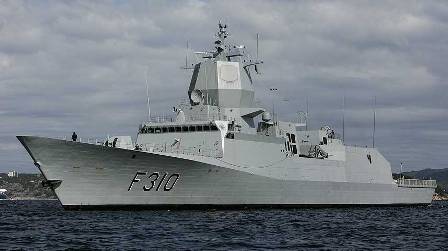Fridtjof Nansen-class
Summary
| Origin country | 🇳🇴 Norway |
| Category | Frigate |
| Subtype | Missile frigate |
| Manufacturer | Navantia, Ferrol, Spain |
| Year commissioned | 2006 |
| Approx. unit cost | $489 million |
| Units | F310 FRIDTJOF NANSEN, F311 ROALD AMUNDSEN, F312 OTTO SVERDRUP, F313 HELGE INGSTAD, F314 THOR HEYERDAHL |
Description
The Fridtjof Nansen-class frigates serve as the primary surface combatants in the Royal Norwegian Navy. This class comprises vessels named after renowned Norwegian explorers, with the eponymous lead ship honoring the famed explorer Fridtjof Nansen. These frigates were constructed by the Spanish shipbuilder Bazan, now known as Navantia, under a project that was projected to cost 21 billion Norwegian kroner, equating to approximately USD 2.44 billion as of 2009. As of November 2018, the class originally included five ships, with four actively serving and one having sunk and subsequently scrapped.
Originally commissioned to replace the aging Oslo-class frigates, the Nansen-class was to focus on anti-submarine warfare. The design evolved into a multi-role platform to facilitate an advanced anti-aircraft defense system and to integrate the Naval Strike Missile, developed by the Norwegian company Kongsberg Defence & Aerospace. Spanish contractor Navantia's selection influenced the ships' design, resulting in similarities to Spain's Álvaro de Bazán-class frigates, including the use of the Lockheed Martin AEGIS combat system.
The Nansen-class frigates boast significant improvements over their Oslo-class predecessors, being substantially larger in size and water displacement, with increased personnel capacity and equipment potential. They originally operated NFH NH90 helicopters to enhance their anti-submarine and anti-surface warfare capabilities. However, these helicopters were scheduled to be withdrawn from service by 2022 and returned to NH Industries. Norway announced in 2023 the acquisition of six MH-60R helicopters, initially designated for the Norwegian Coast Guard but capable of anti-submarine operations. The plan for the Nansen-class frigates includes technical upgrades beginning in 2025, as per the National Defence Acquisitions Plan for 2023–2030.
The operational history of this class is notable for participation in several international efforts. The lead ship, Fridtjof Nansen, was deployed to the Gulf of Aden in February 2009 to participate in Operation Atalanta—a European Union counter-piracy initiative off the coast of Somalia. HNoMS Helge Ingstad, another ship of the class, teamed up with the Danish vessel HDMS Esbern Snare in December 2013 to escort cargo ships transporting Syrian chemical weapons to be handed over to the US Navy for destruction in international waters. The Helge Ingstad, however, suffered a severe collision with the oil tanker Sola TS while returning from Exercise Trident Juncture in November 2018, leading to significant damage and its eventual sinking and scrapping due to prohibitive repair costs.
The remaining ships of the class, named after explorers Roald Amundsen, Otto Sverdrup, Helge Ingstad, and Thor Heyerdahl, continue to serve, honoring their legacy of exploration and Norway's maritime tradition.
Technical specifications
| Fridtjof Nansen | |
|---|---|
| Displacement | 5121 tons |
| Range | 900 km at 16 knots |
| Crew | 146 members |
| Width | 16.8 m (55.1 ft) |
| Length | 134.0 m (439.6 ft) |
| Air Park | 1 NHI NH90 helicopter |
| Propulsion | 1 General Electric LM 2500 gas turbine with a power of 38,350 hp - 2 propellers |
| Thrust | 3600 hp |
| Armament | 1 Mk.41 VLS (32 missiles) + 8 NSM (IV 2) + 1 76mm OTO-Melara Compact gun + 2 12.7mm machine guns + 4 533mm T/ASM + 1 NH-90 helicopter |
| Maximum speed | 27 knots |
Photo of Fridtjof Nansen class
